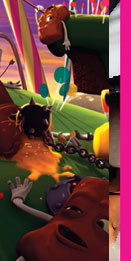アートギャラリー:「適応」
| 場所:ホール A | 開催時間 |
| 2009年12月17日(木) | 09:30 - 18:30 |
| 2009年12月18日(金) | 09:30 - 18:30 |
| 2009年12月19日(土) | 09:30 - 17:00 |
現実の社会に存在する課題とそれに取り込む機会について考える―今存在するものを将来存在するかもしれないものに適応させることにおいて、アートとテクノロジーの飛躍的な成果が見られます。
世界が急速に進化する今、アーチストや研究者にその最前線を見せてもらいましょう。シーグラフアジア2009のアートギャラリーとエマージングテクノロジーの展示は「適応」をテーマとしています。アートギャラリーでは、最先端のデジタルメディア技術を駆使した作品から、技術社会に疑問を投げかけるような作品まで、多様で国際的なアートが展示されます。
Truce: Strategies for Post-Apocalyptic Computation (Juried)

In their seminal paper, “Flying in Tune: Sexual recognition in mosquitoes”, Gabriella Gibson and and Ian Russell from the University of Greenwich discovered an inspiring phenomenon: male mosquitoes change their buzzing frequency to match that of female mosquitoes. This synchronization brings their wing beats to within a millisecond or less of one another. The authors suggest that this phenomenon facilitates mosquitoes’ ability to copulate mid-flight. Truce exploits this phenomenon to engage living mosquitoes in song, inspired by the North Indian classical vocal tradition of Dhrupad. The installation explores reciprocal musical interactions between the mosquito and the computer. The computer produces a stimulus sound to which the mosquitoes synchronize. Subsequently, the computer sings a third voice that responds to the musical inflections of the mosquitoes’ buzz. These three voices come in and out of harmony depending on the mosquitoes' propensity to maintain sync with the stimulus signal. Each mosquito is equipped with a loud-speaker that delivers the stimulus signal, a sensitive microphone for picking up the mosquito's buzz, a camera for a closer look at the insect, a kinetic component that allows the mosquito to rest every few minutes, and a light bulb that shows the mosquito’s activity.
Robin Meier Ali Momeni University of Minnesota

